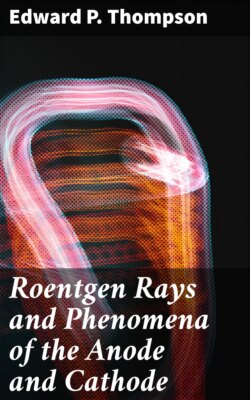Roentgen Rays and Phenomena of the Anode and Cathode

Реклама. ООО «ЛитРес», ИНН: 7719571260.
Оглавление
Edward P. Thompson. Roentgen Rays and Phenomena of the Anode and Cathode
Roentgen Rays and Phenomena of the Anode and Cathode
Table of Contents
PREFACE
INTRODUCTION
CHAPTER I
CHAPTER II
CHAPTER III
CHAPTER IV
CHAPTER V
CHAPTER VI
CHAPTER VII
CHAPTER VIII
CHAPTER IX
CHAPTER X
CHAPTER XI
CHAPTER XII. Miscellaneous Researches on Roentgen Rays
CHAPTER XIII. A few Typical Applications of X-rays in Anatomy, Surgery, Diagnosis, etc
CHAPTER XIV. Theoretical Considerations
Отрывок из книги
Edward P. Thompson
Published by Good Press, 2021
.....
11. Glow by Discharge. Glow Changed to Spark. Motion of Air. Continuous Discharge During Glow. The glow was most easily obtained in rarefied air. The electrodes were of metal rods about .2 of an inch in diameter. He also obtained a glow in the open air by means of one or both of the small rods. He noticed some peculiarities of the glow. In the first place, it occurred in all gases and slightly in oil of turpentine. It was accompanied by a motion of the gas, either directly from the light or towards it. He was unable to analyze the glow into visible elementary intermittent discharges, nor could he obtain any evidence of such an intermittent action, § 8a. No sound was produced even in open air. § 9. He was able to change the brush into a glow by aiding the formation of a current of air at the extremity of the rod. He also changed the glow into a brush by a current of air, or by influencing the inductive action near the glow. The presentation of a sharp point assisted in sustaining or sometimes even in producing the glow; so also did rarefaction of the air. The condensation of the air, or the approach of a large surface tended to change the glow into a brush, and sometimes into a spark. Greasing the end of the wire caused the glow to change into a brush.
12. Lullin’s Experiment. Spark. Penetrating Power. Passage Through Solids. Encyclo. Brit. Article Electricity. He placed a piece of cardboard between two electrodes and discovered that a spark penetrated the material and left a hole with burnt edges. When the electrodes were not exactly opposite each other, the perforation occurred in the neighborhood of the negative pole. Later experiments have shown that a glass plate, 5 or 6 cm. in thickness, can be punctured by the spark of a large induction coil. The plate should be large enough to prevent the spark from going around the edges. The spark is inclined, also, to spread over the surface of the glass instead of piercing it, § 24. Glass has been cracked by the spark in some experiments.
.....